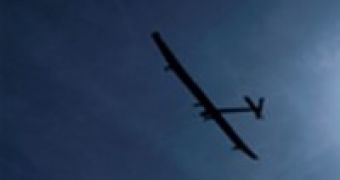This experimental airplane was launched on Wednesday and landed safely in Switzerland 24 hours later. It successfully flyed through the night and its energy lasted longer than expected. This is the first step towards flying around the globe using the power of the Sun as fuel. Andre Borschberg, a former fighter jet pilot from Switzerland, landed the plane about 50km from the Swiss capital Bern at 9 am (7 am GMT).
Its 10,748 solar cells on its wingspan stored enough energy to power the plane. The 63,40m aircraft only weights 1,600kg, it has four engines and also bateries that allow flying after sundown. It is constructed around a skeleton of carbon fibre-honeycomb composites, in a sandwich assembly. The surface of the upper wing is covered in encapsulated cells underneath which there is a lightweight flexible film. Between these two surfaces, 120 carbon fibre ribs at fifty centimeters interval give the wing its aerodynamic shape.
The Solar Impulse team led by Mr Borschberg and aviator Bertrand Piccard and the plane's designers said that this successful experiment swows that a plane can be kept in the air around the clock. Mr Piccard told jusnalists that this is the first time ever that a solar plane has flown during the night."That was the moment that proved the mission was successful, we made it.".
At the end of the 24-hour flight, the plane still had three hours power left in its batteries, which was much more than expected. Bertrand Piccard added: "Nothing can prevent us from another day and night, and the myth of perpetual flight.".
Swiss adventurer Betrand Piccard made history when, in 1999, he circled the globe in a hot-air ballon. His team's new goal is to built a new and more advanced model of the plane that will hopefully allow circumnavigate the globe by 2013.

 14 DAY TRIAL //
14 DAY TRIAL //